Mango puree is a versatile and delicious ingredient that brings the tropical sweetness of mangoes to a variety of dishes. Made by blending fresh, ripe mangoes into a smooth and creamy texture, mango puree is a staple in many kitchens due to its natural flavor and vibrant color. Whether you’re preparing a refreshing smoothie, a decadent dessert, or a flavorful marinade, mango puree adds a unique touch to both sweet and savory recipes.
Homemade mango puree is especially appealing because it allows you to control the freshness and sweetness, ensuring a healthier and more personalized option compared to store-bought alternatives. Packed with essential nutrients like vitamin C, antioxidants, and dietary fiber, it’s not only delicious but also nutritious. In this blog post, you’ll learn how to make an amazing mango puree, discover creative ways to use it in your favorite recipes, and get tips on storing it for future use. Get ready to elevate your cooking with this tropical delight.
Table of Contents
What is Mango Puree?
Understanding Mango Puree
A smooth and thick blend made from fresh mangoes, this tropical creation captures the fruit’s essence in its purest form. It’s made by peeling and removing the seed of ripe mangoes, then blending the fruit flesh into a creamy, uniform consistency. This simple process lets you enjoy the rich flavor and vibrant color of this beloved fruit in a versatile format for countless dishes.
What makes this tropical blend so special is its adaptability. It enhances both sweet and savory recipes, making it a must-have ingredient in any kitchen. From decadent desserts like mango mousse and sorbet to savory options like salad dressings and marinades, this puree unlocks endless culinary possibilities. Its natural sweetness reduces the need for extra sugar, offering a healthier option for those cutting down on refined sweeteners.
Besides its culinary uses, this fruit-based blend is packed with health benefits. Mangoes are rich in vitamin C, which supports immunity, along with antioxidants that fight free radicals. The puree also retains the fruit’s fiber, promoting healthy digestion. Whether you’re making a quick tropical smoothie or adding it to a baby’s diet as a wholesome option, it’s both nutritious and delicious.
One of the best aspects of this preparation is its convenience. It can be made ahead and stored in the fridge or freezer, saving time in the kitchen. Whether you’re crafting a refreshing drink on a hot summer day or preparing a flavorful sauce for a dinner party, this puree is the perfect way to add the tropical goodness of mangoes to your dishes.
Benefits of Mango Puree
This tropical puree offers a range of benefits that make it a favorite in kitchens around the world. From its exceptional flavor to its health advantages, it’s a versatile addition to countless recipes.
- Nutritional Value
This puree is packed with essential nutrients, making it a healthy choice for various dishes. It is a rich source of vitamin C, which boosts immunity and promotes healthy skin. Additionally, it contains dietary fiber to aid digestion and support gut health. Loaded with antioxidants, it helps fight free radicals and reduce inflammation. For a natural energy boost, the sugars in this puree provide a quick and wholesome source of fuel. - Versatility in Cooking
One of the greatest benefits of this tropical ingredient is its versatility. It works beautifully in both sweet and savory dishes, making it a must-have for creative cooking. Use it as a base for smoothies, desserts, or salad dressings. This puree also pairs wonderfully with proteins like chicken and fish when used in marinades, adding a tropical twist to meals. Its smooth texture and rich flavor open up endless possibilities in the kitchen. - Natural Sweetness
This tropical blend provides a natural sweetness that can replace processed sugars in many recipes. Whether you’re crafting a dessert or a healthy snack, it enhances flavor without relying on artificial sweeteners. It’s an excellent choice for anyone looking to manage sugar intake while still enjoying delicious treats. - Child-Friendly and Allergen-Free
Mango puree is a fantastic option for kids and those with dietary restrictions. It’s a common ingredient in baby food because of its smooth texture and naturally sweet flavor. Since mangoes are generally considered hypoallergenic, mango puree is a safe choice for individuals with food sensitivities or allergies. - Storage-Friendly
One of its standout benefits is its convenience for storage. Refrigerate this puree for short-term use or freeze portions for long-term availability, ensuring you always have this tropical ingredient ready. This ease of storage makes it perfect for meal prepping and helps reduce food waste.
Common Uses for Mango Puree
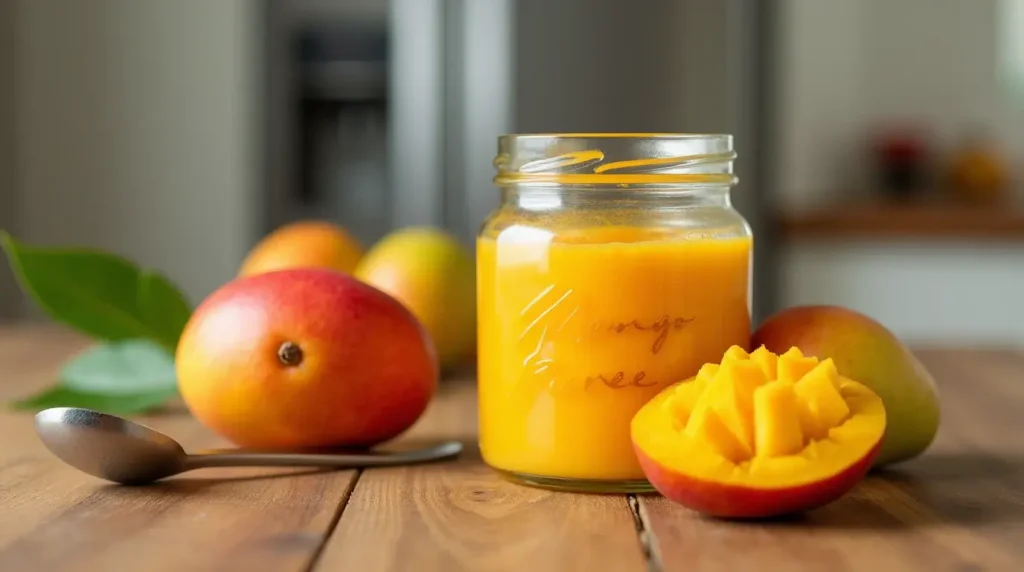
Mango puree is a highly versatile ingredient that can be used in a wide range of dishes, from sweet treats to savory delights. Its natural sweetness, creamy texture, and vibrant color make it a favorite among home cooks and professional chefs alike. Here are some of the most common ways to incorporate mango puree into your cooking:
1. Sweet Dishes and Desserts
Mango puree shines in desserts, adding a burst of tropical flavor to everything from cakes to frozen treats. It can be layered into parfaits, swirled into cheesecake batter, or folded into whipped cream for a light and fruity mousse. Ice creams and sorbets are also popular choices, where mango puree serves as the main flavoring ingredient. It’s perfect for drizzling over pancakes, waffles, or crepes as a naturally sweet topping.
2. Smoothies and Beverages
Adding mango puree to your favorite smoothies instantly elevates the flavor with a tropical twist. Combine it with other fruits like bananas, pineapples, or berries for a refreshing drink. It can also be stirred into yogurt or milkshakes to create creamy, indulgent beverages. For those who enjoy cocktails, mango puree makes an excellent base for tropical drinks like margaritas or mojitos.
3. Baby Food
Mango puree is an ideal option for baby food, especially for introducing little ones to the flavors of tropical fruits. Its natural sweetness means there’s no need to add sugar, and its smooth texture is gentle on sensitive tummies. You can serve it as is or mix it with other pureed fruits like bananas or apples for a nutrient-packed meal.
4. Savory Sauces and Marinades
Although mango puree is most commonly associated with sweet recipes, it also works beautifully in savory dishes. Use it as a base for salad dressings, adding a unique fruity flavor to greens. It’s also excellent for marinades, particularly for chicken, shrimp, or fish, where the sweetness balances the savory spices. Mango puree can even be used to create chutneys or spicy dipping sauces that pair wonderfully with grilled meats or appetizers.
5. Baking and Cooking Enhancements
In baking, mango puree can be used to add moisture and flavor to cakes, muffins, and bread. It’s also a fantastic addition to oatmeal or granola, adding both sweetness and texture. For savory cooking, a small amount of mango puree can be blended into soups, stews, or curries for a subtle hint of sweetness that balances bold spices.
How to Make an Amazing Mango Puree
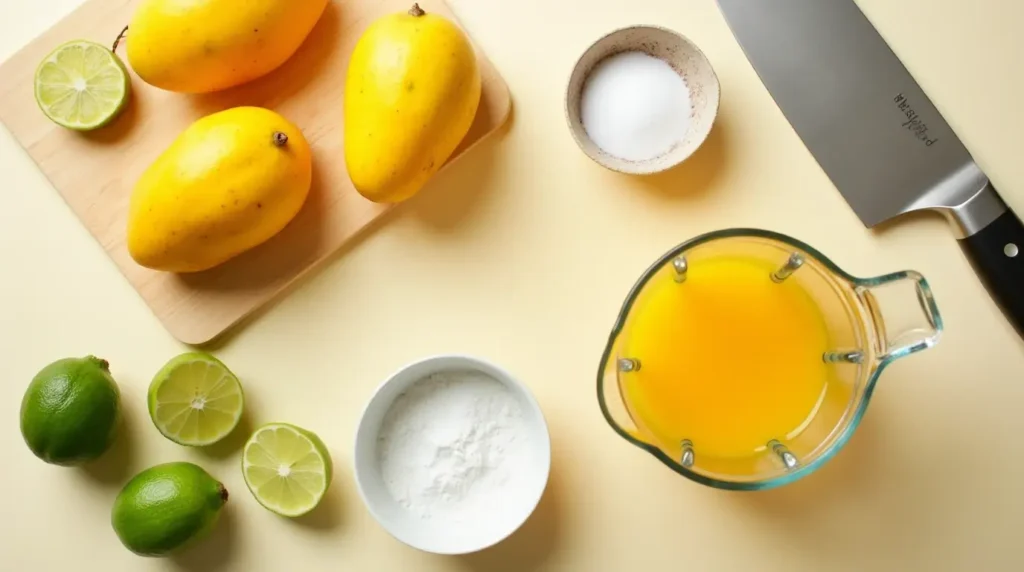
Ingredients Needed
Making mango puree at home is simple and requires just a handful of ingredients. The key to creating a smooth and flavorful mango puree is selecting the right ingredients and preparing them properly. Here’s what you’ll need:
Fresh Mangoes
The star ingredient for mango puree is, of course, mangoes. Choose ripe, juicy mangoes for the best flavor and texture. Varieties like Alphonso, Ataulfo, or Tommy Atkins are ideal for making mango puree because of their natural sweetness and low fiber content. Look for mangoes that feel slightly soft when pressed but are not overly mushy.
Optional Sweeteners
Depending on how you plan to use the mango puree, you may want to add a touch of sweetness. Natural sweeteners like honey, agave syrup, or a small amount of sugar can enhance the flavor, especially if the mangoes are slightly tart. For desserts, this can create a more indulgent taste, while for savory dishes, a lighter touch may be preferred.
Citrus Juice
A splash of lime or lemon juice can balance the sweetness of the mango puree and add a hint of brightness. Citrus juice also helps preserve the vibrant color of the puree, especially if you’re storing it for later use. This ingredient is optional but highly recommended for enhancing the overall flavor profile.
Water or Milk (Optional)
For certain recipes, you might need to adjust the consistency of your mango puree. Adding a small amount of water can make the puree smoother and more pourable, perfect for drinks or dressings. Alternatively, for a creamier texture, you can use milk or a dairy-free alternative like coconut milk, depending on the dish you’re preparing.
Tools You’ll Need
Creating mango puree at home is straightforward and requires just a few essential kitchen tools. With the right equipment, you can achieve a smooth and consistent texture, making the puree perfect for a variety of recipes. Here’s what you’ll need:
- Blender or Food Processor
The most important tool for making mango puree is a blender or food processor. These devices efficiently break down fresh mango chunks into a silky-smooth puree in seconds. Whether you’re using a high-speed blender or a compact food processor, make sure it’s clean and powerful enough to handle the fruit’s fibrous texture. - Knife and Cutting Board
Preparing mangoes for pureeing starts with a sharp knife and a sturdy cutting board. A sharp knife makes it easy to peel and slice the mango, while the cutting board provides a stable surface for dicing the fruit into smaller pieces before blending. - Spoon or Scoop
If your mangoes are soft and ripe, a spoon or scoop is ideal for removing the flesh from the skin and seed. This tool minimizes waste and ensures you extract the maximum amount of fruit for your mango puree. - Fine-Mesh Sieve (Optional)
For those who prefer an ultra-smooth mango puree, a fine-mesh sieve can be used to strain the mixture after blending. This step removes any leftover fibers or lumps, resulting in a creamy and refined texture, perfect for desserts or sauces. - Measuring Cups or Kitchen Scale
Measuring tools like cups or a kitchen scale come in handy when you need a specific amount of mango puree for a recipe. Precision is particularly important for baking or dishes where exact quantities are crucial. - Storage Containers or Ice Cube Trays
If you’re making mango puree in bulk, airtight storage containers are essential for keeping it fresh in the refrigerator. Ice cube trays are another great option for freezing small portions of mango puree, making it easy to use later in smoothies or recipes.
Step-by-Step Instructions
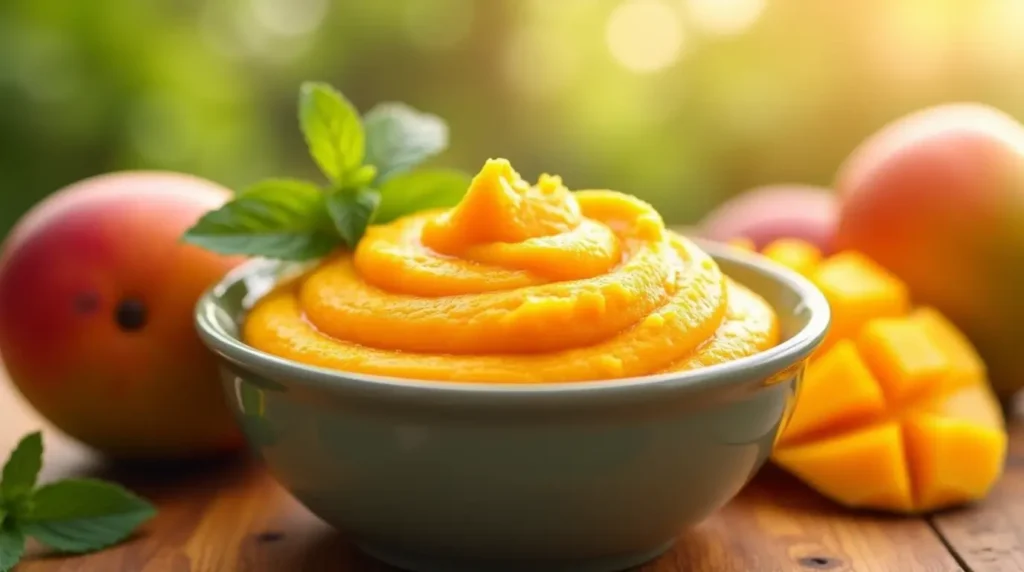
Making mango puree at home is incredibly simple and rewarding. By following these easy steps, you’ll create a fresh and flavorful mango puree that can be used in a wide variety of recipes. Here’s how you can make it:
1. Choose the Right Mangoes
Start by selecting ripe mangoes with a sweet aroma and vibrant color. Popular varieties such as Alphonso, Ataulfo, or Tommy Atkins are excellent choices for making mango puree. Ensure the mangoes are free of blemishes and feel slightly soft to the touch. The quality of the mangoes directly affects the taste and texture of your puree.
2. Prepare the Mangoes
Wash the mangoes thoroughly under running water to remove any dirt or residue. Use a sharp knife to peel the skin, either by making vertical cuts or using a vegetable peeler. After peeling, slice the mango flesh away from the pit. Aim to extract as much flesh as possible to maximize the yield of your mango puree.
3. Blend to Perfection
Place the mango pieces into a blender or food processor. If your mangoes are naturally sweet, you may not need any additional sweeteners. However, you can add a small amount of sugar, honey, or lime juice if you want to enhance the flavor. Blend until the mangoes turn into a smooth and creamy texture. Scrape down the sides of the blender as needed to ensure all pieces are fully incorporated.
4. Adjust the Consistency
If the puree is too thick for your liking, you can thin it out by adding a splash of water, milk, or even coconut milk, depending on how you plan to use the mango puree. Blend again briefly to combine the liquid with the mango puree evenly.
5. Taste and Refine
Once blended, taste the mango puree and adjust the sweetness or tanginess to suit your preference. You can add a pinch of salt or a dash of lemon juice for a balanced flavor profile, especially if you’re planning to use the puree in savory recipes.
Sweet Recipes Using Mango Puree
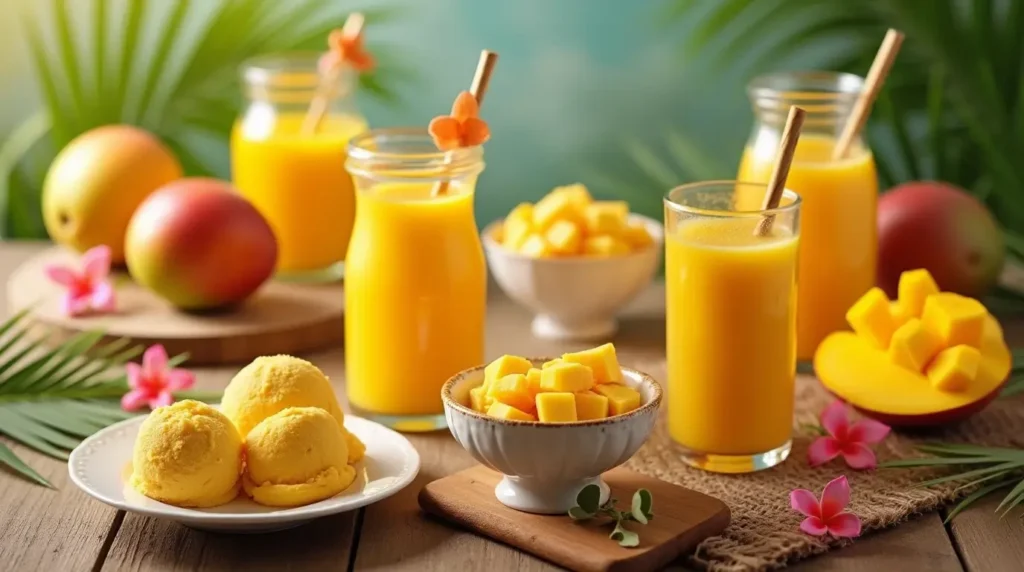
Mango Puree for Smoothies
Mango puree is the perfect base for creating refreshing and nutritious smoothies. Its natural sweetness and creamy texture make it an excellent addition to smoothie recipes, enhancing both flavor and consistency. Whether you’re preparing a tropical blend or a healthy post-workout drink, mango puree can easily elevate your smoothie game.
To make a delicious mango smoothie, simply combine mango puree with other fruits such as bananas, pineapples, or berries for a tropical twist. Add a splash of your favorite liquid, like orange juice, coconut water, or almond milk, to balance the flavors and create the desired consistency. For another tropical-inspired treat, you might also enjoy this refreshing Hugo Spritz recipe, perfect for pairing with mango-based beverages.
One of the biggest advantages of using mango puree in smoothies is its versatility. It complements a variety of fruits and works well with ingredients like spinach or kale for a nutrient-packed green smoothie. Plus, it’s a great way to use up leftover mango puree you might have on hand from other recipes.
For a quick and easy recipe, blend one cup of mango puree with half a banana, a handful of frozen pineapple chunks, and a cup of coconut water. The result is a vibrant, tropical smoothie that’s perfect for a refreshing breakfast or an afternoon pick-me-up. You can also customize it further by adding a drizzle of honey or a pinch of cinnamon for added flavor.
Mango Puree for Desserts
Mango puree is a versatile ingredient for crafting irresistible desserts that capture the vibrant, tropical essence of mangoes. Its creamy texture and natural sweetness make it an excellent base for a wide range of sweet treats, enhancing recipes with depth and color without the need for excessive sugar or artificial additives.
A standout dessert you can create with this tropical blend is mango mousse. This light and airy treat combines the fruit’s goodness with whipped cream or yogurt, resulting in a luscious delight perfect for any occasion. For more dessert inspiration, check out this recipe for Neapolitan Ice Cream or create a twist on traditional waffles with these Strawberry Waffles. Simply fold mango puree into whipped cream, add a touch of sweetener if desired, and chill the mixture for a few hours to set. The outcome is a dessert that feels indulgent yet remains refreshingly simple to prepare.
Another crowd-pleaser is mango ice cream, showcasing the flexibility of this vibrant ingredient. Whether using an ice cream maker or opting for a no-churn method, this tropical star acts as the main flavoring. Blend it with cream, condensed milk, and a splash of lime juice to create a homemade ice cream bursting with tropical goodness. The bright yellow hue adds visual appeal to this delicious dessert.
For those who enjoy baking, this fruit puree is a wonderful addition to cakes and cupcakes. It can be mixed into the batter to enhance moisture and provide a subtle fruity flavor to your creations. Alternatively, swirl it into cheesecakes or use it as a topping for panna cotta, delivering a fresh, fruity contrast to creamy desserts.
If you’re seeking a healthier option, this sweet ingredient pairs perfectly with chia pudding or layered yogurt parfaits. Its natural sweetness complements the nutty taste of chia seeds or the tanginess of yogurt, resulting in a dessert that is both indulgent and nutrient-packed.
Mango Puree for Baby Food
Mango puree is an excellent choice when it comes to preparing healthy and delicious meals for babies. Its natural sweetness and smooth texture make it an ideal first food for little ones, while also providing essential nutrients to support their growth and development. Unlike store-bought baby foods, this homemade option ensures that your baby gets the freshest and most wholesome meals without added sugars or preservatives.
To prepare it for your baby, start by choosing a ripe mango that is soft to the touch and fragrant. Varieties such as Alphonso or Ataulfo mangoes are perfect for baby food because of their naturally sweet flavor and smooth consistency. Wash the mango thoroughly, peel the skin, and remove the pit. Cut the flesh into small pieces and blend until smooth. If the consistency is too thick, you can add a small amount of breast milk, formula, or water to achieve the desired texture.
This tropical treat is not only tasty but also packed with vital nutrients like vitamin C, which supports a healthy immune system, and dietary fiber, which aids digestion. Additionally, its vibrant color and tropical flavor can make mealtime more exciting for your baby.
For safety, ensure that the puree is smooth and free of lumps to avoid choking hazards, especially for younger babies. It’s also a good idea to introduce it in small quantities initially and observe your baby for any potential allergic reactions. This blended fruit can be served on its own as a standalone meal or mixed with other fruits like bananas or apples for a delightful combination.
When making baby food, you can prepare a larger batch and store it for later use. Refrigerate it in an airtight container for up to three days, or freeze it in small portions using an ice cube tray for longer storage. This way, you’ll always have fresh fruit blends on hand to make feeding time both nutritious and convenient.
Savory Recipes Using Mango Puree
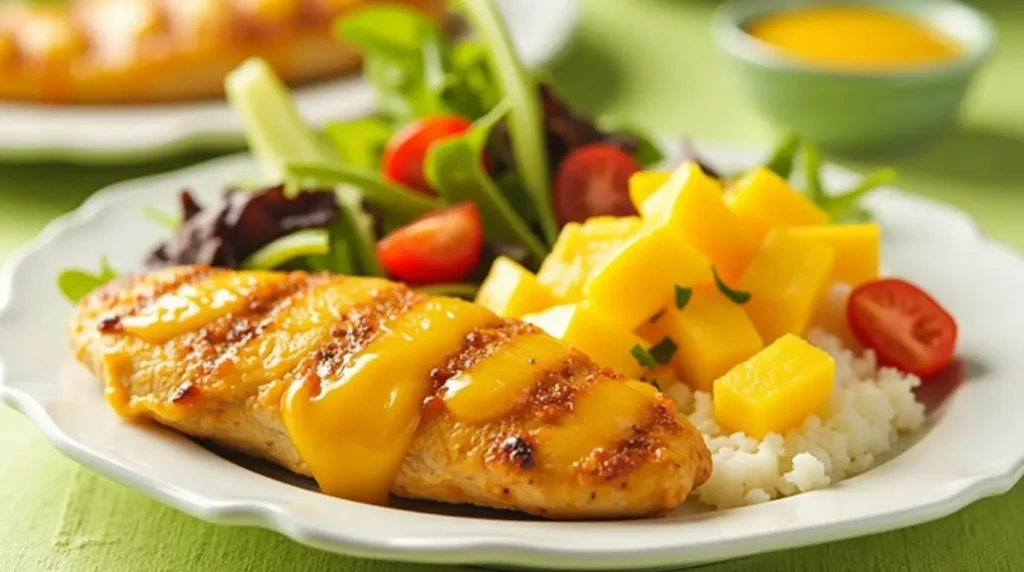
Mango Puree for Salad Dressings
Mango puree is a fantastic base for creating vibrant, flavorful salad dressings that can transform even the simplest salads into something extraordinary. Its natural sweetness pairs beautifully with tangy and savory ingredients, making it ideal for a variety of dressings. Whether you’re preparing a summer fruit salad or a green leafy mix, mango puree can add a refreshing twist that enhances the overall flavor profile.
To make a mango puree-based salad dressing, start with fresh mango puree as the star ingredient. Combine it with olive oil, a splash of lime or lemon juice for tanginess, and a hint of honey or agave syrup to balance the flavors. For a savory kick, add a pinch of salt, freshly ground black pepper, and a dash of Dijon mustard. If you’re looking for more complexity, try adding a touch of minced garlic or finely chopped herbs like cilantro or mint.
This type of dressing pairs especially well with salads that include ingredients like arugula, spinach, avocado, grilled chicken, or nuts. The creamy texture of mango puree creates a smooth, luscious dressing that clings to the salad greens perfectly, ensuring every bite is full of flavor. You can also customize the consistency of the dressing by adding water or additional olive oil, depending on your preference.
Mango Puree for Marinades
Mango-based puree is an exceptional ingredient for marinades, offering a natural sweetness and tropical flavor that enhances a variety of dishes. The rich, creamy texture allows it to coat proteins like chicken, fish, or shrimp evenly, ensuring the flavors seep into every bite. Its natural acidity, combined with its sweetness, helps tenderize meats while adding a delightful fruity undertone.
One of the best things about using this tropical fruit blend in marinades is its versatility. You can pair it with ingredients like lime juice, garlic, ginger, soy sauce, or chili flakes to create a balanced flavor profile. For example, a marinade made with the puree, lime juice, and a touch of honey creates the perfect glaze for grilled chicken or salmon. Adding spices like paprika or cumin can give it a bold, smoky kick, ideal for barbecues or oven-roasted dishes.
These marinades are not only delicious but also quick and easy to prepare. Simply blend fresh mango with your chosen spices, herbs, and liquids, then let the protein marinate for at least 30 minutes (or longer for deeper flavor). This ensures the natural enzymes in the fruit work to tenderize the meat while infusing it with a sweet and tangy taste.
This method works especially well for tropical-inspired dishes. These fruit-based marinades can be paired with coconut rice, roasted vegetables, or fresh salads to create a well-rounded meal. The vibrant color also gives your dishes an appealing presentation, making them perfect for entertaining or impressing your guests.
Mango Puree for Dips and Sauces
This tropical fruit base is an excellent foundation for creating dips and sauces that bring a burst of flavor to your meals. Its natural sweetness, vibrant color, and creamy texture make it a versatile ingredient for both simple and complex recipes. Whether you’re hosting a gathering or enhancing everyday dishes, it can transform ordinary dips and sauces into something extraordinary.
One popular option is using this ingredient to make a sweet and spicy mango salsa. This salsa pairs perfectly with tortilla chips, grilled chicken, or even fish tacos. To prepare it, combine the base with diced tomatoes, red onions, fresh cilantro, lime juice, and a pinch of chili for a delightful balance of sweet and tangy flavors.
For a more indulgent option, consider making a mango chutney. By blending this puree with ingredients like vinegar, sugar, and warming spices such as ginger and cinnamon, you can create a rich, flavorful sauce that complements roasted meats, cheeses, or even warm bread.
It’s also ideal for creamy sauces. For example, mix this fruit blend with yogurt, honey, and a touch of lemon juice to create a refreshing dressing for salads or a dip for fresh vegetables. Alternatively, combine it with coconut milk, garlic, and a hint of curry powder to create a savory sauce that pairs beautifully with rice, shrimp, or tofu dishes.
Mango puree is a fantastic base for dips like mango salsa or chutney. These fruity dips pair wonderfully with snacks like tortilla chips or spicy chips. If you’re looking to try some new chip recipes, check out these Top 3 Crunchy Spicy Chips Recipes to Ignite Your Snack Game for inspiration.
Tips for Storing and Using Mango Puree
How to Store Mango Puree
Proper storage of mango puree is essential to preserve its fresh flavor, vibrant color, and nutritional value. Whether you’ve prepared a small batch for immediate use or made extra for future recipes, following the right storage methods ensures that your mango puree stays fresh and safe to enjoy. Here are some effective ways to store it:
1. Refrigeration for Short-Term Use
If you plan to use your mango puree within a few days, refrigeration is the best option. Transfer the puree into an airtight container to prevent it from absorbing any odors from other foods in the fridge. Properly stored, mango puree can last for up to 3 to 5 days in the refrigerator. To keep it as fresh as possible, place it in the coldest part of the fridge rather than in the door compartments.
2. Freezing for Long-Term Storage
For longer storage, freezing mango puree is a fantastic option. Start by portioning the puree into small freezer-safe containers or ice cube trays. This allows you to easily thaw only the amount you need for a recipe without defrosting the entire batch. Once frozen, transfer the puree cubes or portions into a resealable freezer bag, removing excess air to prevent freezer burn. Properly frozen mango puree can last for up to 3 months, retaining its flavor and texture.
3. Thawing Mango Puree
When you’re ready to use frozen mango puree, thaw it in the refrigerator overnight. Avoid microwaving it, as this can alter its flavor or consistency. Once thawed, give it a quick stir to restore its smooth texture before incorporating it into your recipes.
4. Tips for Optimal Storage
- Always label containers or freezer bags with the date of preparation to keep track of freshness.
- If you notice any changes in smell, color, or texture after storing, it’s best to discard the puree.
- For added convenience, you can freeze mango puree in portions that match common recipe quantities, such as ½ cup or 1 cup.
Creative Uses for Leftover Mango Puree
Leftover mango puree is a fantastic ingredient that can be used in a variety of ways to enhance your meals and snacks. Instead of letting it go to waste, you can transform it into delightful creations that showcase the tropical flavor of mangoes. Here are some creative and practical ways to use mango puree in your everyday cooking:
- Add It to Beverages
Mango puree makes a wonderful addition to drinks. Stir a spoonful into your morning smoothie for an extra burst of sweetness and tropical flavor. It also works well in cocktails like mango margaritas or mocktails for a refreshing twist. For a quick and easy treat, mix mango puree with sparkling water or lemonade to create a fruity soda. - Enhance Your Breakfast
Use mango puree to upgrade your breakfast staples. Drizzle it over pancakes, waffles, or French toast as a flavorful alternative to syrup. It also pairs beautifully with oatmeal or yogurt parfaits, adding natural sweetness and a pop of vibrant color to your dish. For a delightful twist, consider pairing mango puree with homemade bread. Check out this Easy Kaiser Roll Recipe: Step-by-Step Guide to Baking This Classic Bread for inspiration. - Use as a Baking Ingredient
Mango puree can be incorporated into baked goods for a unique tropical touch. Replace part of the liquid in your cake, muffin, or bread recipes with mango puree to infuse them with a subtle mango flavor. You can even use it as a filling for tarts or pastries. - Create Flavorful Sauces and Dressings
Transform your mango puree into a delicious sauce or salad dressing. Combine it with olive oil, vinegar, and spices to create a mango vinaigrette that’s perfect for green salads. Alternatively, mix it with soy sauce, ginger, and chili for a tangy glaze that pairs well with grilled meats or seafood. - Freeze It for Future Use
If you’re not ready to use all your mango puree right away, freezing is an excellent option. Pour the puree into ice cube trays and freeze for individual portions. These frozen mango cubes can later be added to smoothies, soups, or sauces whenever you need them. For a simple recipe to complement your mango creations, consider making this 4-Ingredient Banana Bread, which pairs perfectly with a dollop of mango puree. - Sweeten Your Snacks
Mango puree is a great addition to snacks like popsicles or fruit leather. Mix it with other pureed fruits, pour into molds, and freeze to create healthy and refreshing mango popsicles. For fruit leather, spread the puree thinly on a baking sheet and dry it in the oven for a naturally sweet snack. - Incorporate It into Savory Dishes
Mango puree isn’t just for sweet recipes—it works wonders in savory dishes too. Use it as a base for curry, combine it with coconut milk for a rich sauce, or blend it into soups for a touch of tropical sweetness.
Choosing the Best Mangoes
Selecting the right mangoes is essential for making a high-quality mango puree. The flavor, texture, and overall quality of your mango puree depend largely on the type and ripeness of the mangoes you choose. Here’s a detailed guide to help you pick the best mangoes for your recipe:
1. Opt for Ripe Mangoes
Ripe mangoes are key to achieving a naturally sweet and flavorful mango puree. Look for mangoes that have a slight give when you gently press them. They should not be too hard or overly soft. A ripe mango will have a vibrant color, though this varies depending on the variety. For example, some mangoes may stay green while ripening, while others turn yellow or red.
2. Check for Sweet Aroma
A ripe mango will emit a sweet, fruity aroma near the stem. This natural scent is an excellent indicator of ripeness and ensures that your mango puree will have a rich and delightful flavor.
3. Avoid Mangoes with Imperfections
Inspect the mango skin for any dark spots, bruises, or wrinkling, as these could indicate that the mango is overripe or damaged. While a few minor blemishes may not affect the puree, heavily bruised or spoiled mangoes should be avoided.
4. Know the Best Mango Varieties
Certain mango varieties are better suited for making mango puree. Popular choices include:
- Alphonso Mango: Known for its intense sweetness and creamy texture, ideal for desserts.
- Ataulfo Mango (Honey Mango): Smaller in size with a buttery texture, perfect for smooth mango puree.
- Kent Mango: Juicy with minimal fibers, making it easy to blend into a puree.
- Haden Mango: Slightly tangy and flavorful, great for a balance of sweetness and acidity.
5. Buy Seasonal Mangoes
Whenever possible, choose mangoes that are in season. Seasonal mangoes are fresher, more flavorful, and often more affordable. Using seasonal mangoes ensures that your mango puree will have the best possible taste and texture.
6. Handle Mangoes with Care
Once you’ve selected your mangoes, handle them gently to avoid bruising. Store them at room temperature until they are fully ripe. If you’re not ready to use them immediately, ripe mangoes can be refrigerated to prolong their freshness.
Wrapping Up Your Mango Puree Journey
Mango puree is a truly versatile ingredient that can transform your culinary creations with its natural sweetness, vibrant color, and tropical flavor. Whether you’re using it to whip up a refreshing smoothie, craft a decadent dessert, or add a unique twist to savory dishes, mango puree offers endless possibilities for both novice and experienced cooks alike.
One of the best things about mango puree is its simplicity. With just ripe mangoes and a blender, you can create a fresh and delicious puree in minutes. By making your own at home, you get to enjoy all the health benefits of this nutrient-packed ingredient, free from preservatives and artificial sweeteners often found in store-bought options. Plus, homemade mango puree allows you to customize its sweetness and consistency to perfectly match your recipes.
From mango mousse and tropical cocktails to salad dressings and marinades, the culinary applications of mango puree are as diverse as your imagination. Don’t forget that mango puree can also be a fantastic base for baby food or a healthy snack for kids. Its natural sweetness and creamy texture make it a favorite across all age groups.
As you experiment with mango puree, remember the importance of selecting the best mangoes, storing the puree properly, and exploring both sweet and savory uses. Each recipe you try will not only showcase the versatility of mango puree but also help you appreciate the tropical charm of this incredible fruit.
So why wait? Grab some ripe mangoes, start blending, and discover the magic of mango puree in your kitchen. Whether it’s a light summer treat or a bold addition to your dinner menu, mango puree is sure to become a go-to ingredient for countless recipes. Share your creations, experiment with flavors, and let mango puree take your dishes to the next level!

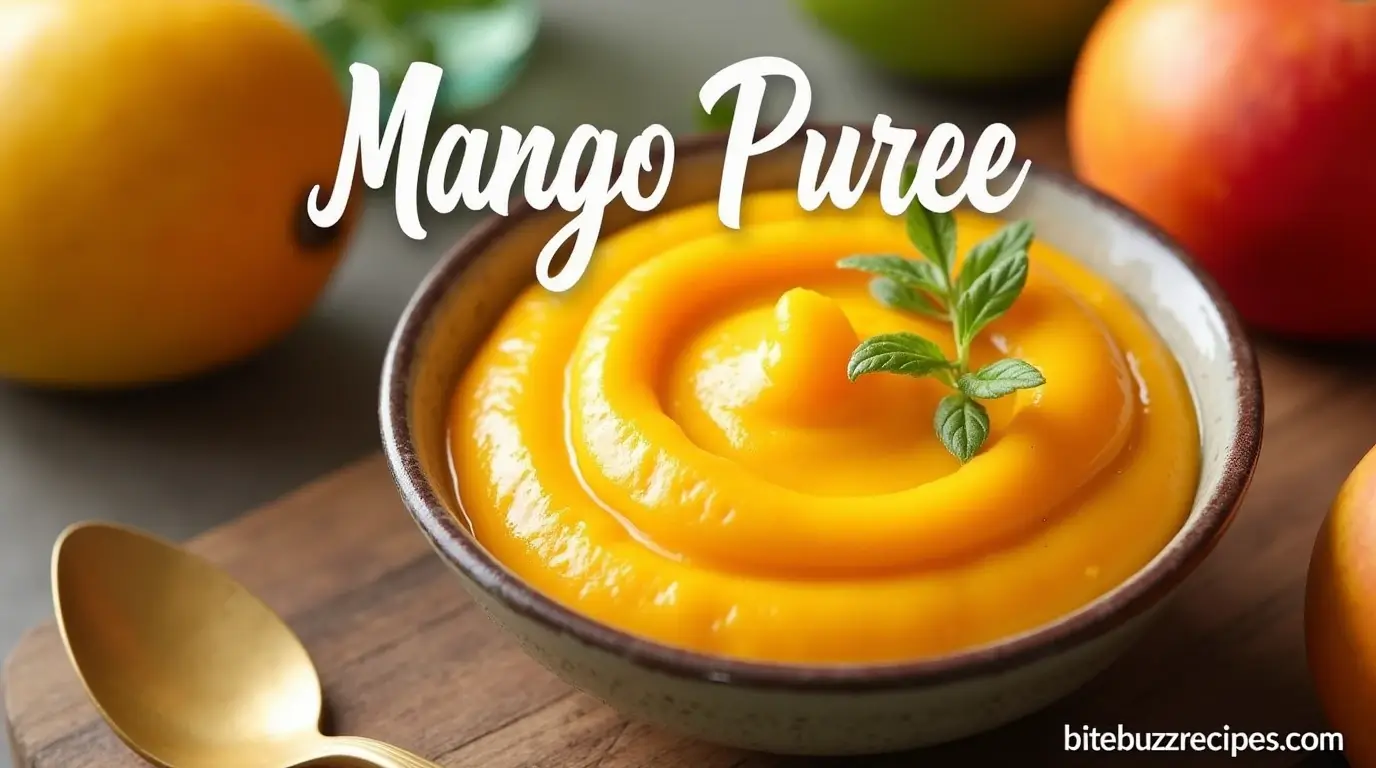
14 thoughts on “How to Make an Amazing Mango Puree for Sweet and Savory Recipes”